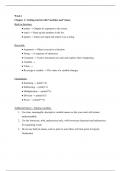Samenvatting
Samenvatting - Inleiding Programmeren voor CIW (800873-B-6) (800873-B-6)
Dit document biedt een uitgebreide samenvatting van het vak "Inleiding Programmeren voor CIW (800873-B-6)." De samenvatting behandelt essentiële concepten en programmeervaardigheden die in de cursus worden onderwezen. Het omvat een overzicht van programmeerfundamenten, zoals variabelen, datastruct...
[Meer zien]




